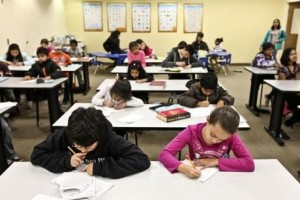A feature story I wrote on afterschool math enrichment centers appeared in today's The Boston Globe Magazine. You can read it online (and see additional links below) by clicking here! I researched and wrote this in the last month or so of my pregnancy, so joke that now I know which math programs my son should try in a few years... A LITTLE BOY, NO OLDER THAN 8, almost leaps out of his chair, screaming, “It’s so easy! It’s so easy!”
Standing at the front of his classroom, Robert Kaplan, a teacher and cofounder of the Math Circle, one of many after-school math enrichment programs in the Boston area, gently chides him. “No, I don’t think it’s easy,” he says. “And it’s not nice to say it is when we’re struggling with the problem.”
It’s not easy for the parents, either, sitting in the back of classrooms during lessons like this and trying to puzzle out a problem themselves. These are folks who have been through the boom and bust of Baby Einstein and Baby Mozart, and who of course want the best for their children’s developing minds. Now they’re trying to decide whether extracurricular math centers, which are spreading through the city and suburbs like a cold in a kindergarten, are worth the investment of time and money.
You can’t drive very far in Greater Boston without coming across one of these schools. Within five minutes of my Framingham home there are four different centers: an ALOHA (an acronym for Abacus Learning of Higher Arithmetic), a Chyten, a Kumon, and the MetroWest School of Mathematics (co-owned by the Russian School of Mathematics). Latha Narayanan, manager of the Framingham and Franklin Kumon centers, calls this small area a “math mall,” and she’s right: Companies with centers in just this corner of the suburbs serve about 1,130 students.
There are at least 14 different programs, with 87 total locations in and around Boston, teaching math enrichment classes to kids (not to mention private tutors, school math clubs, and online instruction). Some of these programs are small – like the Kohlberg Math Learning Center in Harvard Square, which has 12 students, and Girls’ Angle, a Cambridge center with anywhere from 10 to 20 at any time, or Kaplan’s Math Circle, which operates in classrooms on Harvard’s and Northeastern’s campuses and has 156 students and a handful of teachers, including Kaplan and his wife, Ellen. Other programs, like the Newton-based Russian School of Mathematics, which has almost 6,000 students, and the New Jersey-based Kumon, which has 6,192 students in the area, are huge. And they have different teaching approaches: Kohlberg uses a physical learning innovation – blocks made to fit together in groups of 10, 100, and 1,000 – to teach kids in a one-on-one setting; Girls’ Angle offers individualized teaching without a set curriculum; the Russian School offers classroom-based instruction using a set curriculum; and Kumon has a curriculum but offers one-on-one instruction.
With so many programs, parents may wonder if their children shouldn’t be enrolled just to keep pace with their classmates, to say nothing of getting ahead. How can parents know that these programs work and then choose among them?
You can see the print version (as a PDF), with some beautiful pictures, by clicking HERE.
[Note that the answers to the puzzle on page 24 got cut off. The solution is: Next triangle blue (rightside up); 15th is blue (upside down); 44th is white triangle (top facing left). You can also see this online HERE.]
You can also see a PDF version of the web version by clicking HERE.
